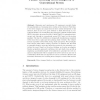Free Online Productivity Tools
i2Speak
i2Symbol
i2OCR
iTex2Img
iWeb2Print
iWeb2Shot
i2Type
iPdf2Split
iPdf2Merge
i2Bopomofo
i2Arabic
i2Style
i2Image
i2PDF
iLatex2Rtf
Sci2ools
MMM
2015
Springer
2015
Springer
Flat3D: Browsing Stereo Images on a Conventional Screen
Expensive and cumbersome 3D equipment currently limits the popularization of emerging stereo media on the Internet. Particularly for stereo images, as a major kind of stereo media widespread on the Internet, there is not yet a good solution to show stereoscopy in conventional display. By investigating the principles of human visual system (HVS), this paper proposes a method, called Flat3D for animating stereoscopy only through a conventional screen (2D) based on the motion parallax. The way for exhibition is dynamically transforming consistent views from left to right and then playing back reversely. The relative motion impresses viewers with strong depth perception. We investigate some factors which affect viewing experience in Flat3D and find that a reasonable fixation point and structure-preserved view transition contribute the most. Based on the above findings, we develop an adaptive fixation acquisition approach combining color and depth cues, as well as employing a probabili...
MMM 2015 | Multimedia |
| Added | 14 Apr 2016 |
| Updated | 14 Apr 2016 |
| Type | Journal |
| Year | 2015 |
| Where | MMM |
| Authors | Wenjing Geng, Ran Ju, Xiangyang Xu, Tongwei Ren, Gangshan Wu |
Comments (0)

